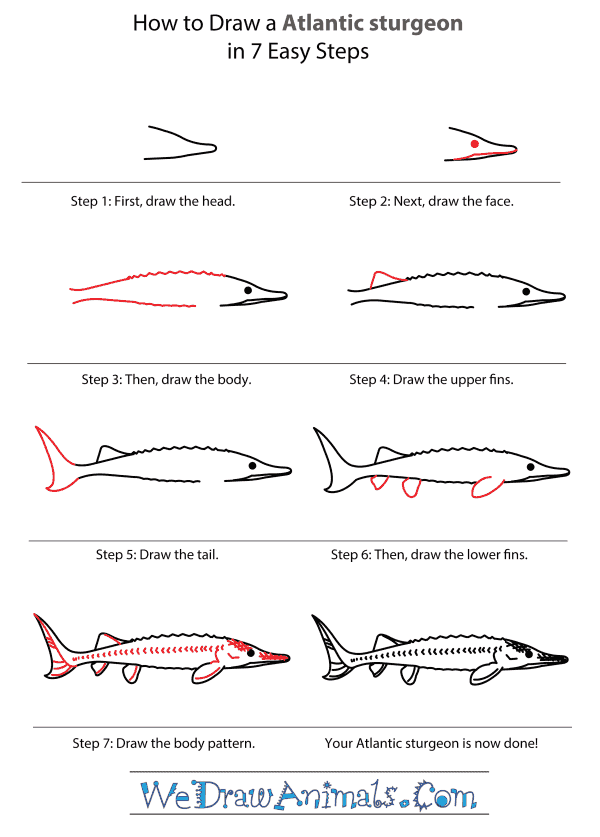In this quick tutorial you'll learn how to draw an Atlantic Sturgeon in 7 easy steps - great for kids and novice artists.
The images above represent how your finished drawing is going to look and the steps involved.
Below are the individual steps - you can click on each one for a High Resolution printable PDF version.
At the bottom you can read some interesting facts about the Atlantic Sturgeon.
Make sure you also check out any of the hundreds of drawing tutorials grouped by category.
How to Draw an Atlantic Sturgeon - Step-by-Step Tutorial
Step 1: To draw this amazing fish, first draw its long bottle-shaped head.
Step 2: Now draw the face. Make a circle for the eye and a bending line for the mouth beginning at the tip of the head and ending to the left of the eye.
Step 3: It's body time! Draw a long ridging line connecting from the top of the head and a similar line for the belly of your fish. Leave an open space between the two lines at the back of your fish for the tail and near the head for the upper fin.
Step 4: Next, draw the dorsal fin.
Step 5: To swim fast, your fish needs a large pointed tail to cut through the water. Your tail should curve up into a point at the top and down to a smaller point at the bottom.
Step 6: Now draw the lower fins which are small and rounded.
Step 7: Draw the patterns of this sea-dwelling fish. Remember to include the spikes along its side and gills so it can breathe.
Interesting Facts about the Atlantic Sturgeon
The Atlantic sturgeon (Acipenser sturio) is a fish that resides on most of the coasts of Europe.
Did you know?
- Atlantic sturgeons spend a lot of time alone at sea, returning to the river they were born in to breed their own young. They are one of the largest fish to breed in rivers.
- The Atlantic sturgeon is also called the European sea sturgeon, the Baltic sturgeon, and the common sturgeon.
- Sturgeons are sometimes referred to as “primitive fish” because they have not physically changed since the early fossil record.
- While the sturgeon can reach up to 20 feet and weight over 800 pounds, their average length is four feet.
- They mostly eat mollusks and crustaceans that they find with their barbels, the sensitive tendrils on the end of their snout.
- For a long time, these fish were used for caviar, but are now an endangered species and are protected.
- Conservationists have been working to reintroduce the sturgeon into the wild.
Lesson plan note: Many animals evolve over the years to adjust to their environment, but the Atlantic sturgeon has stayed the same for as long as we know. Discuss why this might be.








